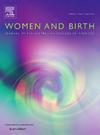“Sleep on side”: Awareness and anxiety around sleeping position during late pregnancy
IF 4.1
2区 医学
Q1 NURSING
引用次数: 0
Abstract
Background
The “Sleep on Side” policy was recently introduced in Australian antenatal clinics to reduce the risk of late stillbirth associated with going-to-sleep on the back.
Aim
To assess knowledge of side sleeping recommendations in pregnancy and explore feelings of anxiety in relation to this policy, and how these feelings may impact sleep.
Methods
Cross-sectional study of sleep position measured for seven nights between 32 and 36 weeks of pregnancy. Participants completed a sleep diary each morning, and at the end of the week completed a survey regarding knowledge and anxiety around sleeping position.
Findings
Sleep position data was collected in 80 participants, with 43 participants completing anxiety surveys. Almost all participants (95 %) reported receiving side sleeping advice during pregnancy, the most common source being their antenatal care provider. Twenty-three percent of women reported “moderate” or “very much” anxiety around their sleeping position or waking on their back overnight. Anxiety towards sleeping position was associated with self-reported supine sleep (p < .001), and use of additional pillows to support behind the back (p < .001). Overall self-reported sleep quality was not affected by anxiety, apart from alertness upon awakening (p = .001).
Discussion
In this cohort, the Sleep on Side policy has been disseminated widely with women understanding the rationale for encouraging a safe sleeping position. While many women receive this advice with minimal worry, almost a quarter of women may experience anxiety that may potentially affect their sleeping behaviour.
Conclusion
Advice on sleeping position should be carefully balanced with potential harms to maternal sleep and mental health.
“侧睡”:怀孕后期对睡姿的意识和焦虑。
背景:澳大利亚产前诊所最近推出了“侧睡”政策,以减少与仰卧睡觉相关的晚期死产风险。目的:评估孕妇侧睡建议的知识,探讨与此政策相关的焦虑情绪,以及这些情绪如何影响睡眠。方法:对怀孕32至36周期间的7个晚上的睡眠姿势进行横断面研究。参与者每天早上完成一份睡眠日记,并在一周结束时完成一项关于睡眠姿势的知识和焦虑的调查。研究结果:收集了80名参与者的睡眠姿势数据,其中43名参与者完成了焦虑调查。几乎所有参与者(95% %)报告在怀孕期间接受过侧睡建议,最常见的来源是产前保健提供者。23%的女性表示,她们对自己的睡姿或夜间仰卧感到“中度”或“非常”焦虑。对睡姿的焦虑与自我报告的仰卧睡眠有关(p )讨论:在这个队列中,侧睡政策已经广泛传播,女性理解鼓励安全睡姿的基本原理。虽然很多女性在接受这一建议时并不担心,但近四分之一的女性可能会感到焦虑,这可能会影响她们的睡眠行为。结论:对产妇的睡姿建议应谨慎权衡对产妇睡眠和心理健康的潜在危害。
本文章由计算机程序翻译,如有差异,请以英文原文为准。
求助全文
约1分钟内获得全文
求助全文
来源期刊

Women and Birth
NURSING-OBSTETRICS & GYNECOLOGY
CiteScore
7.20
自引率
13.20%
发文量
371
审稿时长
27 days
期刊介绍:
Women and Birth is the official journal of the Australian College of Midwives (ACM). It is a midwifery journal that publishes on all matters that affect women and birth, from pre-conceptual counselling, through pregnancy, birth, and the first six weeks postnatal. All papers accepted will draw from and contribute to the relevant contemporary research, policy and/or theoretical literature. We seek research papers, quality assurances papers (with ethical approval) discussion papers, clinical practice papers, case studies and original literature reviews.
Our women-centred focus is inclusive of the family, fetus and newborn, both well and sick, and covers both healthy and complex pregnancies and births. The journal seeks papers that take a woman-centred focus on maternity services, epidemiology, primary health care, reproductive psycho/physiology, midwifery practice, theory, research, education, management and leadership. We also seek relevant papers on maternal mental health and neonatal well-being, natural and complementary therapies, local, national and international policy, management, politics, economics and societal and cultural issues as they affect childbearing women and their families. Topics may include, where appropriate, neonatal care, child and family health, women’s health, related to pregnancy, birth and the postpartum, including lactation. Interprofessional papers relevant to midwifery are welcome. Articles are double blind peer-reviewed, primarily by experts in the field of the submitted work.
 求助内容:
求助内容: 应助结果提醒方式:
应助结果提醒方式:


